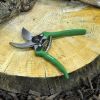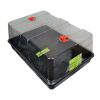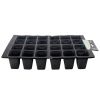How to Propagate your Plant Cuttings (Softwood)
Who says you can’t get something for free? With a little knowledge and a secateurs you can grow your own plants simply from cuttings. Now is the perfect time to get started with softwood cuttings; an easy and cheap way to increase your collection of flowering plant.
What you will need to propagate cuttings
A good, clean and sharp secateurs is essential for making neat cuts, some plant pots (preferably 3 inch, plastic pots), some generally potting compost, sharp sand or perlite for your potting mix, you’ll also need plant labels, a mister, clear plastic bags or cling film, rooting powder and ideally a cold frame.
When is the best time to make softwood cuttings?
Early to Mid summer is most suitable, once the plants have put on some new fresh growth and are still growing strong
A good rule of thumb is that softwood cuttings should be taken when a stem snaps when bent, as appose to bending or not bending
How to make cuttings
- First choose healthy stems for your cuttings. As stated before; you want fresh, green stems that are about 10cm long (length varies depending on plant). Ideally choose straight stems about the thickness of a pencil.
- Next, prepare the cutting by removing the ‘apical’ or terminal bud, this is the bud at the tip of the stem.
- Next you will remove 2/3 of all leaves, starting from the bottom of the stem, up. Removing most of the leaves helps to conserve the cutting’s limited water supply, whilst leaving the remaining leaves allows the cutting to continue making food. If you are using plants with large leaves, i.e. hydrangea it is recommended that you cut the remaining leaves in half.
- Next, make a final cut at the rooting end of the cutting. When doing this you must first find an existing bud or node, make a slanted cut through the stem, keeping the bud or node on the cutting (this is where the new roots will develop from). When making the cut, be sure to that it is neat and clean, making sure not to crush or damage the stem.
- All this should be done promptly. To avoid letting your cuttings dry out keep them out of the sun until they are potted up
Potting up
Pots, trays or containers should always be prepared before making your cuttings; this is to prevent cuttings from drying out. We recommend using cell trays or propagator trays for smaller cuttings such as lavender and 3 inch plastic pots for larger cuttings such as Hydrangea.
Prepare potting mixture:
- 1 part peat-free potting compost
- 1 part perlite or sharp sand
- 15gm superphosphate for every 10 litres of potting mixture
- Mix all well
Superphosphate is a straight fertiliser that promotes root development and growth. Place soil into trays or pots, lightly compress and soak with water. Using a pencil or dibber, make a hole in the centre of each pot, into which the cutting will be placed.
To encourage root establishment we recommend that you use rooting powder. To do so dip the base (1 inch) of each cutting into water and then dip it into the rooting powder (rooting powder is a natural plant hormone that promotes root growth). Shake off the excess powder and place the cutting into the hole made in the compost. Firm in the compost around the cutting making sure that the cutting is secure and won’t move easily.
After care
This is the vital part! The key to cuttings is to keep them moist at all times, without encouraging fungal growth. One common trick is to place a clear plastic bag over pots or using propagator trays, as this will maintain high humidity levels which help retain moisture in the cuttings. Another idea is to mulch the surface of the pots or trays with perlite, again helping to retain moisture in the cutting’s compost.
Position cuttings where they will get light, but not direct sunlight, and assess pots every day. To water use a mister sprayer and spray foliage and compost surface, this can be done every day.
After 2 months the cuttings should have developed sufficient roots and can be potted on into larger pots.
What plants are suited to softwood cuttings
Most herbaceous plants and perennials and some deciduous shrubs and tree are suited to softwood cuttings. The list below is just some of the many options open to propagation through cuttings:
- Lavender
- Hydrangea
- Chrysanthemums
- Dahlias
- Asters
- Fuchsias
- Ivy and Honeysuckle
- Delphiniums
- Buddleja
- Fuchsia
- Betula
- Japanese Maples
Remember, gardening is often about trial and error, so feel free to make cuttings of any garden plants and see if they take, you really have nothing to lose and all to gain!








